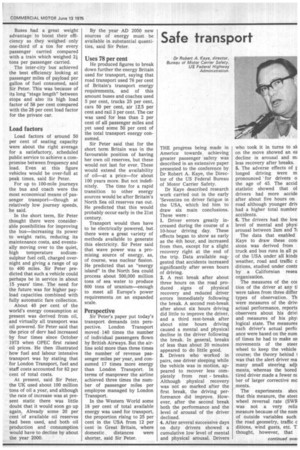Conserving life and fuel
Page 36

Page 37

If you've noticed an error in this article please click here to report it so we can fix it.
Papers presented, at the Confederation of British Road Passenger Transport's first annual conference
AN EFFICIENT bus powered by sulphur-sodium high-temperature fuel cells will be a reality in 15 years time. This prediction was made by Sir Peter Masefieki, member of the London Transport Board, and ex-chairman of the British Airports Authority, in his paper "British transport and the energy problem" given to the inaugural conference of the Confederation of British Road Passenger Transport this week, in Eastbourne.
Sir Peter was very confident of an assured future for road passenger transport. He said that for journeys up to about 150 miles bus would re main the dominant means of travel. He also illustrated the improved technical skill of the bus manufacturers by stating that the "B" type bus of 1910 had 34 seats and did about 204 passenger seat-miles per gallon, about one-third of the figure for a Daimler Fleetline.
For public passenger transport on its own, road transport led the field in terms of revenue miles performed for the amount of fuel used, said Sir Peter. But taken as a whole, only 25 per cent of the energy put into transport came out as useful work. The rest went up in smoke, in heat, In friction and in other losses. Buses had a great weight advantage to boost their efficiency as they weighed only one-third of a ton for every passenger carried compared with a train which weighed 21 tons per passenger. carried.
The inter-city busachieved the best efficiency looking at passenger miles of payload per gallon of fuel consumed, said Sir Peter. This was because of its long "stage length" between stops and also its high load factor of 58 per cent compared with the 28 per cent load factor for the private car.
Load factors
Load factors of around 50 per cent of seating capacity were about the right average for a satisfactory, scheduled public service to achieve a compromise between frequency and load. Even at this figure vehicles would be over-full at peak times, said Sir Peter.
For up to 100-mile journeys the bus and coach were the most economical means of passenger transport—though at relatively low journey speeds, he said.
In the short term, Sir Peter thought there were considerable possibilities for improving the bus—increasing its power to weight ratio, reducing its maintenance costs, and eventually moving over to the quiet, high temperature sodiumsulphur fuel cell, charged overnight and giving a range of up to 400 miles. Sir Peter predicted that such a vehicle could perhaps be in service in about 15 years' time: The need for the future was for higher payload capacities combined with fully automatic fare collection.
About 40 per cent of the world's energy consumption at present was derived from oil, and virtually all transport was oil powered. Sir Peter said that the price of dery had increased by four times since October 1973 when OPEC first raised oil prices. He then illustrated how fuel and labour intensive transport was by stating that for London Transport, fuel and staff costs accounted for 82 per cent of total costs.
At present, said Sir Peter, the UK used about 100 million tons of oil a year, and although the rate of increase was at present static there was little doubt that it would soon go up again. Already some 20 per cent of available oil reserves had been used, and both oil production and consumption would have to decline by about the year 2000. By the year AD 2050 new sources of energy must be safe transport available in substantial quanti
Uses 78 per cent
He produced figures to break down further the energy Britain used for transport, saying that road transport used 78 per cent of Britain's transport energy requirements, and of this amount buses and coaches used 5 per cent, trucks 25 per cent, cars 50 per cent, air 12.5 per cent and rail 3 per cent. The car was used for less than 2 per cent of all passenger miles and yet used some 50. per cent of the total transport energy consumed.
Sir Peter said that for the short term Britain was in the favourable position of having her own oil reserves, but these would not last for ever. These would extend the availability of oil—at a price—for about 100 years more. But not indefi nitely. The time for a rapid transition to other energy sources would be after Britain's North Sea oil reserves ran out. He predicted that this would probably occur early in the 21st century.
Transport would then have to be electrically powered, but. there were a great variety of methods available to generate this electricity. Sir Peter said that wave power was a promising source of energy, as, of course, was nuclear fission. He predicted that an "energy island" in the North Sea could process about 500,000 million tons of sea water to produce 600 tons of uranium—enough to meet all Europe's power requirements on an expanded scale.
Perspective
Sir Peter's paper put today's transport demands into perspective. London Transport moved 140 times the number of individual passengers flown by British Airways. But the airline sold more than three times the number of revenue passenger miles per year, and consumed 17 times more energy than London Transport. In terms of manpower the airline achieved three times the number of passenger miles per employee managed by London Transport.
In the Western World some 18 per cent of total available energy was used for transport, the proportion rising to 25 per cent in the USA from 12 per cent in Great Britain, where domestic distances were shorter, said Sir Peter.




















































































